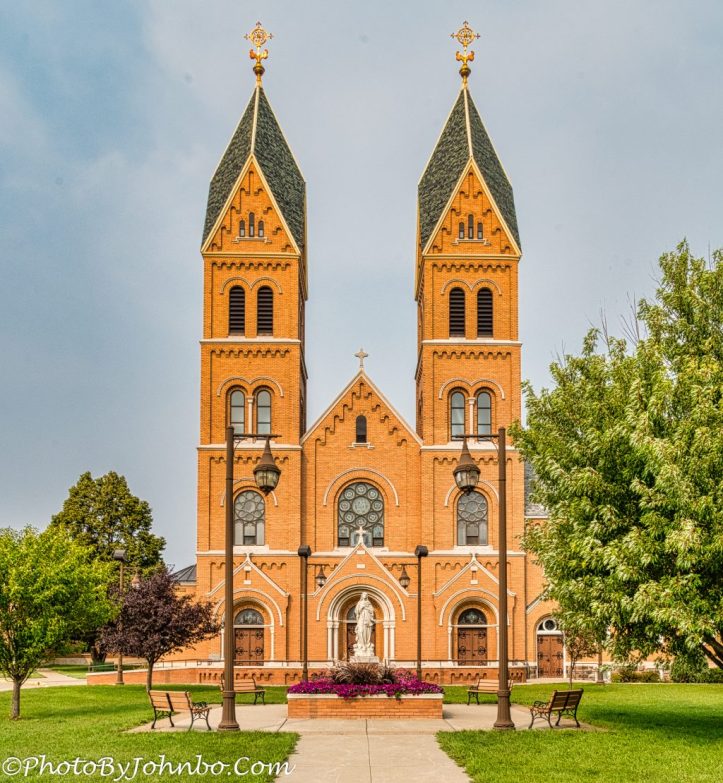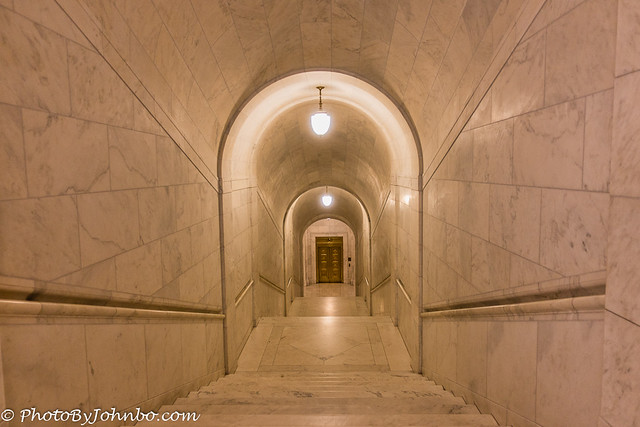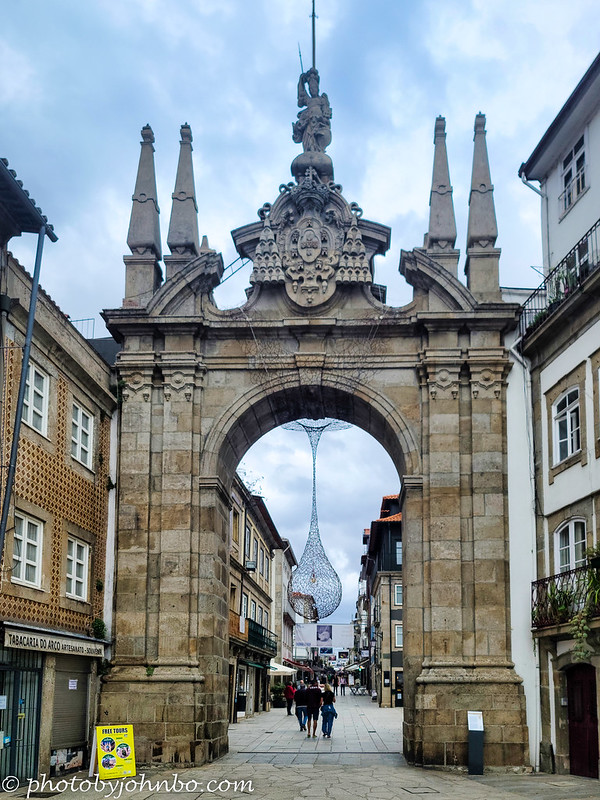
This week, Sofia provided our challenge. She writes, “This week’s challenge may look at first a hard one but, in reality, symmetry is everywhere. It’s also not as static a concept as it may seem. Why is symmetry important as a composition tool in photography? It creates strong and balanced images, affecting the way we feel the subject. Our eyes find symmetry harmonious and pleasing.” You can find her entire challenge post here.
Architectural design is often based on symmetry. I will start my response with a few examples. The church at Assumption Abbey in my home state is a beautiful case in point. In the late 1800’s an order of Benedictine Monks moved to Richardton in Western North Dakota.
The construction of the abbey church began in 1906. The monks had used local brick and stone to build the church, and they had done much of the work themselves. On Christmas Eve, 1908, the monks celebrated their first Mass in their new abbey church. The church was still under construction and finally completed in 1910.
There is much symmetry of design in the United States Supreme Court Building in Washington DC. Magnificent columns, beautiful courtrooms, and massive marble hallways. Even the stairway to the lower level befits the nickname “The Marble Palace” and leads to several offices, the dining room, and the library.
In deference to Sofia’s images from Portugal, I included this symmetrically designed gateway into the central core of Braga.
A Fresnel lens is a type of lens that is made up of a series of concentric rings, each of which has a slightly different curvature. This design allows Fresnel lenses to be much thinner and lighter than traditional lenses, while still maintaining the same optical properties. They are used in lighthouses to focus the light from the lamp, making it visible for a greater distance. Their beautiful design is a result of their functionality.
The front and rear of nearly all vehicles are symmetrical, often mirrored from left to right as in this example of a 1959 Chevrolet Impala. The symmetry is carried into the trunk and the custom designers who added hydraulic lifts (those chrome tubes in the back of the trunk) even continued the symmetry into that area.
Just for fun, I once used the symmetry of a classic Buick to create a pop-art project. Using the Crop tool in Lightroom Classic, I created two photos from one, dividing the Buick front end right down the center. I then printed and mounted the photos in poster frames and hung the posters on either side of a window.
For another project, I photographed a holiday LED light display. I set the ISO to 100, the lens to f/3.5, and the shutter speed to 0.3 seconds. I pressed the shutter button and immediately changed the focal length of the zoom lens by rotating the barrel during the exposure. Because the lights in the display were basically symmetrical, the light trails created were symmetrical as well. If I had used a tripod instead of handholding the camera, the image would have had much straighter light trails.
Sprague Lake in Rocky Mountain National Park created a natural symmetry in the reflection of the clouds, trees, and mountains. For those who might be curious, I did not use any sky replacement tools. If I did, I would ‘fess up. This beautiful sky was reflected in the lake rippling from a light wind. I guess you could say that the image in the lake is a watercolor. (Sorry, I should have warned you that a Dad Joke was coming.)
At La Jolla Cove in southern California, I saw two pelicans standing at slightly different levels on the edge of the shore. If I had captured this image while standing exactly between these two preening birds, It would have been almost perfectly symmetrical except for their height. My question for you is simply, is this a symmetrical or an asymmetrical image? Should I have saved it for next week’s challenge? Feel free to respond in the comments below.
Thank you to everyone who responded to my Billboards and Signs challenge last week. It had the most responses of any challenge I’d posted since joining the Lens-Artists team. About mid-week, WordPress told me that I received a record number of likes in a single day.
Sofia’s challenge this week sent me scurrying through my gallery looking for examples. Thanks, Sofia for a fun challenge, and next week Donna will have us looking at asymmetry. If you’d like to join in the challenge but aren’t quite sure how to get started, check here for details.
John Steiner








Great images. Love the cars!
Thanks, Dawn!
Churches are beautiful
Indeed. They are one of my favorite architectural subjects.
Great post John! Yes, there are some similarities. I would say that your pelicans are best suited for the asymmetrical category. And I liked that you included some zooming effects–one of my favorite things to shoot. Beautiful photography.
Thanks, Anne! You’re probably right about the pelicans!
😊
John, great images! I really like the Fresnel lens.
I have never seen an ugly lighthouse lens. that glass design is always pleasing to look at.
i love the architecture in and around the washington d.c. area, it has a sense of the sacred for a good reason and you captured it with that Supreme Court passage photo.
Thanks! I got several images from the Supreme Court Building that would have qualified, but my post was already getting too long.
Some nicely different examples here. Those cars are quite something!
They are, indeed. I’d love to own a classic like them, but I’m afraid any I buy would mostly sit in a garage. Not a fitting end for such beautiful designs.
Lovely Symmetry clicks.
Love the Abbey click.
Thanks, Philo!
You are welcome, John.
Great pictures…all of them.
Thanks!
Wonderful photos, John, I love the 1959 Chevrolet Impala!
That car happens to be the same color as the 59 Impala I owned as a college student. I would have loved to buy it.
Nice! I’d love to own it too.
Such perfect examples of symmetry, John. Very lovely 🙂
Thanks, Hammad!
Great post, John and thank you for the photo of Braga, which I’ve never visited 😀 Too far north for me, at least until now. Love your cars, they’re perfectly suited for this challenge, but my favourite is the fresnel lens 🙂
Happy to oblige about Braga. 🙂
Lighthouse lenses are all so photogenic.
You photo of the Fresnel lens is spectacular. In fact, all your photos are wonderful 😀 😀
Thanks, Cee! That lighthouse museum is the first one I’ve visited to have a Fresnel lens at eye level for a close look. They make a great subject when you don’t have to try to capture them from the top of the stairway below as in the typical lighthouse installation.
Wow, John! These are stunning photos. Each one I saw I said to myself it was my favorite. I loved the Fresnel lens, the car trunk open, but when I got to Sprague Lake, I took a deep breath. I love Rocky Mtn NP, and that photo is wonderful. Great gallery!
Thanks, Egidio! I appreciate your compliment!
Great entry – love especially (your) cars! The Fresnel lens is a beauty too, should be difficult to construct.
I was looking at it and thought to myself what a disaster if someone dropped it. 🙂
😀
Fabulous examples John, love the cars 🙂
Thanks, Brian!
Wow. Great selections John, carefully chosen. Love the abbey. Does that photo have a special effect applied? LOVE the POV on the Chevy Impala. Superb angles.
Thanks, John. Like most of the images I take with either my Nikon or Sony cameras, I take three exposures with -1, 0, and +1 exposure compensation. Then I use Adobe Lightroom to process it into an HDR blend. From there, on to Luminar Neo for final tweaks.
All of the images except for Braga are from three-exposure brackets.
That Impala’s cat’s eye tail lights begged me to take the photo. >grin<
Woof. Lotta processing, but the final result is worth it!
Lightroom handles the process quickly and efficiently. I’ve also used Luminar Neo when sometimes Lightroom classic leaves banding, especially in the sky.
🤔🤷♂️ I just take pictures. 😵💫
The car photos are unique!!
Thanks, Nora! I’m always trying to find something different about a car since, especially these days, they all look so similar.
beautiful samples I love the Fresnel lens and city shots and and as you mentioned La Jolla Cove lot’s of memories came to mind I spent lots of time there back in the day.
Beautifully done John. I loved your photo projects especially. The car posters are marvelous and are so “you” ! The architectural examples are also terrific.
Thanks, Tina! I had a lot of fun and learning plugged into creating those two prints. They were in our Arizona home and when we sold the house, at our “garage sale”, the two posters were the only photos that sold. Of course, I only made maybe $10 or so on the sale, not enough to pay for the frames. >grin<
Awesome pictures John, I love the landscape and the church hallway. Very cool.
Thanks, Robert!
Whether it is symmetrical or not, I like the two pelicans image the best!
Thanks, Hien!
Whoa, so many great choice here John. The information, in addition to the Fresnel lens photo, was interesting. You always bring something unique to the challenges. I like what felt like perfection of the Abbey photo and like Egidio, a breath of fresh air at Sprague Lake. I might go with asymmetry on the pelicans but with them looking away from each other, they are a mirror image to each other.
Thanks, Donna. I am thinking next week’s challenge will be more difficult to find examples. 🙂
lol. maybe. It was initially hard to shift gears, but I think you will find it is another theme where there is more narrowing down. I’m sure you have a great archive, and I will look forward to it.
Great examples. Particularly like the stairway in the Supreme Court building
Thanks!
Wonderful shots, each and every one, but if I have to choose a favorite, I’m going to say the clouds reflecting on the water. I went back to read the descriptions and see that one is from my “backyard” at RMNP. I live on the front range.
You live in a beautiful neighborhood. Thanks, Laura.
That gold Fresnel lens!! We don’t have those on this coast! I’m smitten.
They really do their job hidden away at the top of lighthouses, at least those that haven’t been taken out of commission. 🙂
[…] Lens-Artist Photo-Challenge John:…Symmetry […]
Great stuff! Thank you for sharing with us!!
Thanks for taking the time to comment!
Wow! Amazing photos of different kinds of symmetry. Love the cars, the church, the stairway and the lights. Hard to pick a favorite here, they are all so good.
Thanks, Anita!